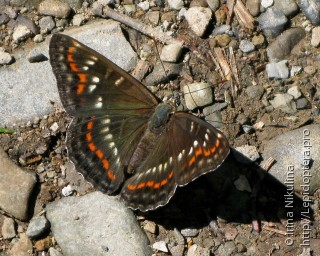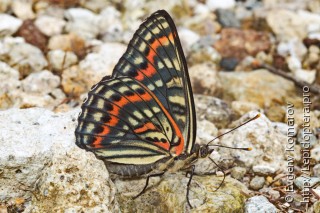Seokia pratti (Leech, 1890)

Taxonomy
class Insecta → subclass Pterygota → infraclass Neoptera → superorder Holometabola → order Lepidoptera → superfamily Papilionoidea → family Nymphalidae → subfamily Limenitidinae → tribe Limenitidini → genus Seokia → species Seokia pratti
Species name(s)
Seokia pratti (Leech, 1890) = Limenitis pratti Leech, 1890 = Limenitis prattii. [3, 9]
urn:lsid:insecta.pro:taxonomy:23208
Expansion
This species marks on the maps: 4.
Zoogeographical regions
Palaearctic.
Russia regions
#40. Primorsky.
Wingspan
55—70 mm.
Flight time
| January | February | March | April | May | June | July | August | September | October | November | December |
Larva lifespan
| January | February | March | April | May | June | July | August | September | October | November | December |
Over-wintering stage
Larva.

Detailed information with references
Distribution
- Regions of the Russian Federation: Seaside. [3].
- Outside view of the Russian Federation known in the northern, eastern and central China and Korea
In Russia, only found in the Primorsky Krai, which comes to the northern edge of its range.Discovered in Terneisky, Yakovlevsky, Chuguyivske, Ussuri, Nadezhda, Shkotovsky, Partizansky, Lazovsky, Olginskiy and Khasan district, in the suburbs of Vladivostok and Arsenyev.Despite the large number of well-known collection points, the real range of the species in the Maritime region is not known; we should expect more widespread seok in the Sikhote-Alin. [96].
- Primorye inhabit butterfly subspecies eximia Moltrecht, 1909 = Ussuriensia jefremovi Nekrutenko, 1960 [2].
Imago Habitus and Differences from alike species
- The wingspan of 55-70 mm, the background color of the wings is dark brown with a raven sheen. The top male PC sharpened. Along the outer edge of both wings are marginal and near-edge broken sling from brownish-red spots, closer to the middle krylev- sash of white spots.The female is slightly larger than the male, she rounded a PC, white spots and a sling is much larger. Bright and multicolored drawing the underside of the wings form alternating yellowish, reddish and white sling and spots on a dark background [103].
General info about Imago
- Rare, locally, on a wide and accessible enough for winds in the mountain ridges of cedar-broadleaf forests at altitudes of 400-1000m above sea level Females are often hidden in the crowns, down to the streams to drink. Males fly from mountain streams and forest roads, especially in the active sundial [2].
Imago lifespan
- From mid-July until September [2].
General info about Larva
- Caterpillar length of 3.7 mm hatches 10-12 days. She ocher, with a black head and longitudinal rows of short bristles. In the first 1.5-3 hours completely eats chorion. Eat in the evening and at night, damaging the needles from the sides. 2-3 days sits at the tip of the needle, but then proceeds to its base. The head turns to the twig.Shedding by 11-12 days, then after 15-16 days after molting eats exuvium.
In the second half of November in the 3rd age falls into diapause in the branches of cedar. Development continues in mid-April. At the beginning and at the end of May again sheds. Caterpillar 5th age 40 mm long, completely invisible on the twig of cedar.On both sides it is dark brown, dark sand on top with dark olive spots at subdorsalnyh whitish spines and tubercles. The head is olive-gray with two short horns. On the dorsal side of 2,3,5,7, 9 and 11th segments paired spines long 3,5-4mm. In other segments (except 1st) similar growths approx. 1 mm long.Along the back of a broken brown stripe on the sides of a row of white strokes. [121].
Larva food plants / other food objects
- Pinus koraiensis (Korean pine and Korean cedar) [2].
Pupa
- Pupation - on a branch near the feeding area. Pupa dark smoky, 27mm long, is dotted with thin brown lines and strokes. On the dorsal side of the 4-6 th abdominal segments paired pugovkovidnye swelling. Breast lug expressed. On his head is no outgrowths. In their place cellular depressions. Cremaster trapezoidal.Immediately after pupation until soft chitin, chrysalis hangs parallel branches. After hardening of the abdominal segments, it deviates from the branches by about 40 degrees .. The top of the pupae from the head to the 3rd tergite brown, which makes it look like a speck. Butterfly hatches on the 19th day after pupation. [121].
Egg
- Eggs ocher, round, fine-meshed. Females lay eggs in the afternoon, one on the tips of cedar needles of different ages in the middle and lower part of the crown [2].
Overwintering stage
- Caterpillar third age [121].
Subspecies of Seokia pratti
- Seokia pratti coreana (Matsumura, 1927). [9]
- S. p. eximia (Moltrecht, 1909). [9]
Authors
Photos:
Irina Nikulina, Evgeny Komarov.
Text data: Peter Khramov, Irina Nikulina.
The species characteristics formalization: Peter Khramov, Sergei Kotov.
References
- [2] Коршунов Ю. П. Булавоусые чешуекрылые Северной Азии. М.: КМК, 2002
- [3] Каталог чешуекрылых (Lepidoptera) России. Под ред. С. Ю. Синёва. СПб.; М.: Товарищество научных изданий КМК, 2008
- [9] Tree of Life (funet.fi), 2012
- [96] Красная книга Приморского края. http://redbookpk.ru/
- [103] Сочивко А.В. Каабак Л.В. Определитель бабочек России. Дневные бабочки. М.: Астрель, 2012
- [121] Омелько, М.А. Биология перламутровки пенелопы – Arginnis zenobia penelope Stg. и ленточницы исключительной – Seokia eximia Molt. (Lepidoptera: Nymphalidae) в Приморье /М.А. Омелько, М.М. Омелько // Биология некоторых видов вредных и полезных насекомых Дальнего Востока. Владивосток: ДВНЦ АН СССР, 1978:
Comments
Note: you should have a Insecta.pro account to upload new topics and comments. Please, create an account or log in to add comments




















